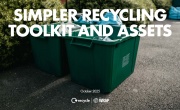Latest WEEE figures suggest UK may miss 2018 targets

Environment Agency figures show that for the first nine months of 2018 altogether, 378,200 tonnes of household WEEE were collected, with large household appliances such as fridges and washing machines the most commonly collected items at 128,559 tonnes. Just over 6,000 tonnes of non-household WEEE were collected during this period.
In order to be on course to reach the 2018 collection target of 537,065 tonnes of household WEEE, the total amount of WEEE collected after nine months would have to be more than 402,798 tonnes – the statistics show that the figure is slightly short of that.
Robbie Staniforth, Policy Manager at compliance scheme Ecosurety, which helps producers meet their recycling targets, has expressed concern that these figures indicate industry will not meet its WEEE recycling targets for 2018. He said: “It seems that the industry is still running slightly behind for Q3, with 70 per cent of our annual target so far accounted for. This is concerning – it suggests producers may again be forced to use the compliance fee in order to hit their targets.”
This would be a continuation of the poor results of 2017, which saw industry fall 100,000 tonnes short of its 2016/17 collection target of 622,033 tonnes. Compliance fees for that year totalled £8 million due to low collections, with schemes required to pay a fee to the government to make up for the amount of WEEE that was not recycled against national targets.
The Department for Environment, Food and Rural Affairs (Defra) then reduced WEEE recycling targets for 2018 by an overall 14 per cent compared to 2017 targets, a move that was met with dismay by industry figures, with some complaining that the new targets lacked ambition. However, these latest figure suggest this may not be the case.
However, Staniforth did suggest that the low figures could be down to a number of factors, stating: “It remains to be seen whether these low figures are caused by issues of material supply, or simply a failure to report. If the latter, then the industry may need to consider ways to simplify the system to encourage more material to be reported through the regulatory mechanism. The need for 'substantiated estimates' [estimates of the amount of WEEE treated outside of the WEEE recycling system and thus not reported] to hit targets is sub-optimal.”
As well as ‘sub-optimal’ reporting, WEEE recycling rates are also affected by the issue of free-riding by online retailers who do not properly declare the amount of EEE they place on the market, mainly through selling directly to consumers from outside the EU.
Earlier this year, a report by the Organisation for Economic Co-operation and Development (OECD) stated that free-riding could lead to inflated WEEE recycling rates, as the number of products placed on the market is underestimated.
 Strong results for battery recycling
Strong results for battery recycling
Figures for portable battery recycling for the third quarter of 2018 have also been released, showing that there was a strong increase in the amount of batteries collected – 4,635 tonnes of waste batteries were collected in Q3 compared to 3,257 in Q2, bringing the UK total up to 11,741 for 2018. The indicative UK obligation for the year is 16,884 tonnes, so the industry is well on its way to meeting that target.
The target collection rate for 2018 is 45 per cent of the average annual amount of portable batteries placed on the market in 2016, 2017 and 2018 – 37,520 tonnes. The UK collection rate for 2018 to date is at 31.8 per cent.
Staniforth said he was “heartened to see the sharp increase in mixed household batteries reported in Q3. This last period has seen one of the highest levels of collection since the regulations began eight years ago”.
He linked the strong results to Ecosurety’s Bring Back Heavy Metal campaign with behaviour change charity Hubbub, which was first launched in 2017 to promote retail collection points for batteries. He added: “Although the UK is currently a little behind the target, we anticipate another period of high collection in Q4.”










